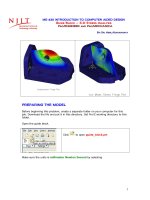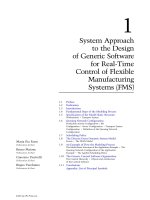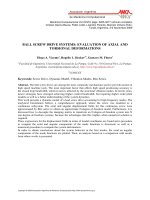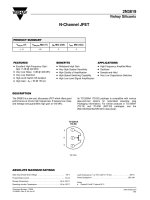Spatial Multiplexing and Channel Modeling docx
Bạn đang xem bản rút gọn của tài liệu. Xem và tải ngay bản đầy đủ của tài liệu tại đây (1.94 MB, 34 trang )
1
7: MIMO I: Spatial Multiplexing and Channel Modeling
Fundamentals of Wireless Communication, Tse&Viswanath
7. MIMO I: Spatial Multiplexing and
Channel Modeling
2
7: MIMO I: Spatial Multiplexing and Channel Modeling
Fundamentals of Wireless Communication, Tse&Viswanath
Main Story
•
So far we have only considered single-input multi-output
(SIMO) and multi-input single-output (MISO) channels.
•
They provide diversity and power gains but no degree-
of-freedom (d.o.f.) gain.
•
D.o.f gain is most useful in the high SNR regime.
•
MIMO channels have a potential to provide d.o.f gain.
•
We would like to understand how the d.o.f gain depends
on the physical environment and come up with statistical
models that capture the properties succinctly.
•
We start with deterministic models and then progress to
statistical ones.
3
7: MIMO I: Spatial Multiplexing and Channel Modeling
Fundamentals of Wireless Communication, Tse&Viswanath
Capacity of AWGN Channel
Capacity of AWGN channel
If average transmit power constraint is watts and
noise psd is watts/Hz,
4
7: MIMO I: Spatial Multiplexing and Channel Modeling
Fundamentals of Wireless Communication, Tse&Viswanath
MIMO Capacity via SVD
Narrowband MIMO channel:
is by , fixed channel matrix.
Singular value decomposition:
are complex orthogonal matrices and
real diagonal (singular values).
5
7: MIMO I: Spatial Multiplexing and Channel Modeling
Fundamentals of Wireless Communication, Tse&Viswanath
Spatial Parallel Channel
Capacity is achieved by waterfilling over the eigenmodes
of H. (Analogy to frequency-selective channels.)
6
7: MIMO I: Spatial Multiplexing and Channel Modeling
Fundamentals of Wireless Communication, Tse&Viswanath
Rank and Condition Number
At high SNR, equal power allocation is optimal:
where k is the number of nonzero λ
i
2
's, i.e. the rank of
H.
The closer the condition number:
to 1, the higher the capacity.
7
7: MIMO I: Spatial Multiplexing and Channel Modeling
Fundamentals of Wireless Communication, Tse&Viswanath
Example 1: SIMO, Line-of-sight
h is along the receive spatial signature in the direction
Ω:= cos φ:
n
r
–fold power gain.
8
7: MIMO I: Spatial Multiplexing and Channel Modeling
Fundamentals of Wireless Communication, Tse&Viswanath
Example 2: MISO, Line-of-Sight
h is along the transmit spatial signature in the direction
Ω := cos φ:
n
t
– fold power gain.
9
7: MIMO I: Spatial Multiplexing and Channel Modeling
Fundamentals of Wireless Communication, Tse&Viswanath
Example 3: MIMO, Line-of-Sight
Rank 1, only one degree of freedom.
No spatial multiplexing gain.
n
r
n
t
– fold power gain
10
7: MIMO I: Spatial Multiplexing and Channel Modeling
Fundamentals of Wireless Communication, Tse&Viswanath
Beamforming Patterns
The receive beamforming pattern
associated with e
r
(Ω
0
):
Beamforming pattern gives the antenna gain in different
directions
11
7: MIMO I: Spatial Multiplexing and Channel Modeling
Fundamentals of Wireless Communication, Tse&Viswanath
Line-of-Sight: Power Gain
Energy is focused along a narrow beam.
Power gain but no degree-of-freedom gain.
12
7: MIMO I: Spatial Multiplexing and Channel Modeling
Fundamentals of Wireless Communication, Tse&Viswanath
Example 4: MIMO, Tx Antennas Apart
h
i
is the receive spatial signature from Tx antenna i
along direction Ω
i
= cos φ
ri
:
Two degrees of freedom if h
1
and h
2
are different.
13
7: MIMO I: Spatial Multiplexing and Channel Modeling
Fundamentals of Wireless Communication, Tse&Viswanath
Example 5: Two-Path MIMO
A scattering environment provides multiple degrees of
freedom even when the antennas are close together.
14
7: MIMO I: Spatial Multiplexing and Channel Modeling
Fundamentals of Wireless Communication, Tse&Viswanath
Example 5: Two-Path MIMO
A scattering environment provides multiple degrees of
freedom even when the antennas are close together.
15
7: MIMO I: Spatial Multiplexing and Channel Modeling
Fundamentals of Wireless Communication, Tse&Viswanath
Rank and Conditioning
•
Question: Does spatial multiplexing gain increase
without bound as the number of multipaths increase?
•
The rank of H increases but looking at the rank by itself
is not enough.
•
The condition number matters.
•
As the angular separation of the paths decreases, the
condition number gets worse.
16
7: MIMO I: Spatial Multiplexing and Channel Modeling
Fundamentals of Wireless Communication, Tse&Viswanath
Back to Example 4
h
i
is the receive spatial signature from Tx antenna i
along direction Ω
i
= cos φ
ri
:
Condition number depends on
17
7: MIMO I: Spatial Multiplexing and Channel Modeling
Fundamentals of Wireless Communication, Tse&Viswanath
Beamforming Patterns
The receive beamforming pattern
associated with e
r
(Ω
0
):
L
r
is the length of the antenna
array, normalized to the carrier
wavelength.
•
Beamforming pattern gives the antenna gain in different directions.
•
But it also tells us about angular resolvability.
18
7: MIMO I: Spatial Multiplexing and Channel Modeling
Fundamentals of Wireless Communication, Tse&Viswanath
Angular Resolution
Antenna array of length L
r
provides angular resolution of
1/L
r
: paths that arrive at angles closer is not very
distinguishable.
19
7: MIMO I: Spatial Multiplexing and Channel Modeling
Fundamentals of Wireless Communication, Tse&Viswanath
Varying Antenna Separation
Decreasing antenna separation
beyond λ/2 has no impact on
angular resolvability.
Assume λ/2 separation from
now on (so n=2L).
20
7: MIMO I: Spatial Multiplexing and Channel Modeling
Fundamentals of Wireless Communication, Tse&Viswanath
Channel H is well conditioned if
i.e. the signals from the two Tx antennas can be resolved.
Back to Example 4
21
7: MIMO I: Spatial Multiplexing and Channel Modeling
Fundamentals of Wireless Communication, Tse&Viswanath
MIMO Channel Modeling
•
Recall how we modeled multipath channels in Chapter 2.
•
Start with a deterministic continuous-time model.
•
Sample to get a discrete-time tap delay line model.
•
The physical paths are grouped into delay bins of width
1/W seconds, one for each tap.
•
Each tap gain h
l
is an aggregation of several physical
paths and can be modeled as Gaussian.
•
We can follow the same approach for MIMO channels.
22
7: MIMO I: Spatial Multiplexing and Channel Modeling
Fundamentals of Wireless Communication, Tse&Viswanath
MIMO Modeling in Angular Domain
The outgoing paths are grouped into
resolvable bins of angular width 1/L
t
The incoming paths are grouped into
resolvable bins of angular width 1/L
r
.
The (k,l )
th
entry of H
a
is (approximately) the
aggregation of paths in
Can statistically model each entry as independent
and Gaussian.
Bins that have no paths will have zero entries in H
a
.
23
7: MIMO I: Spatial Multiplexing and Channel Modeling
Fundamentals of Wireless Communication, Tse&Viswanath
Spatial-Angular Domain Transformation
What is the relationship between angular H
a
and spatial H?
2L
t
£ 2L
t
transmit angular basis matrix (orthonormal):
2L
r
£ 2L
r
receive angular basis matrix (orthonormal):
Input,output in angular domain:
so
24
7: MIMO I: Spatial Multiplexing and Channel Modeling
Fundamentals of Wireless Communication, Tse&Viswanath
Angular Basis
•
The angular transformation decomposes the received (transmit)
signals into components arriving (leaving) in different directions.
25
7: MIMO I: Spatial Multiplexing and Channel Modeling
Fundamentals of Wireless Communication, Tse&Viswanath
Examples









